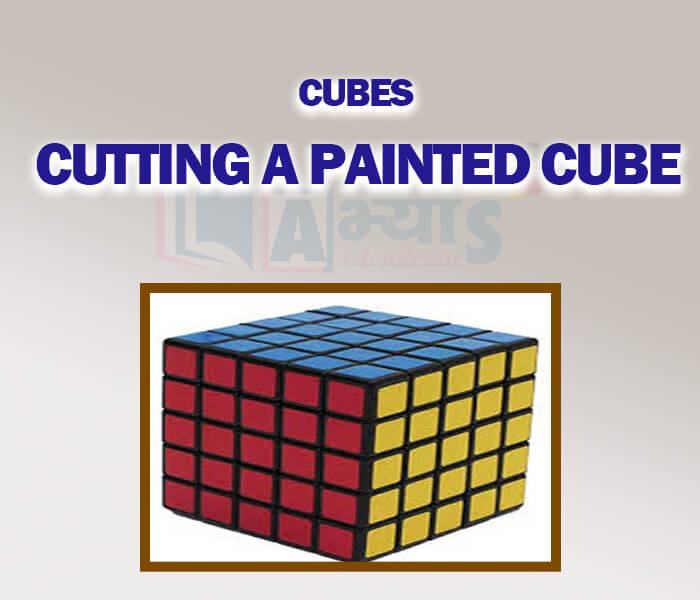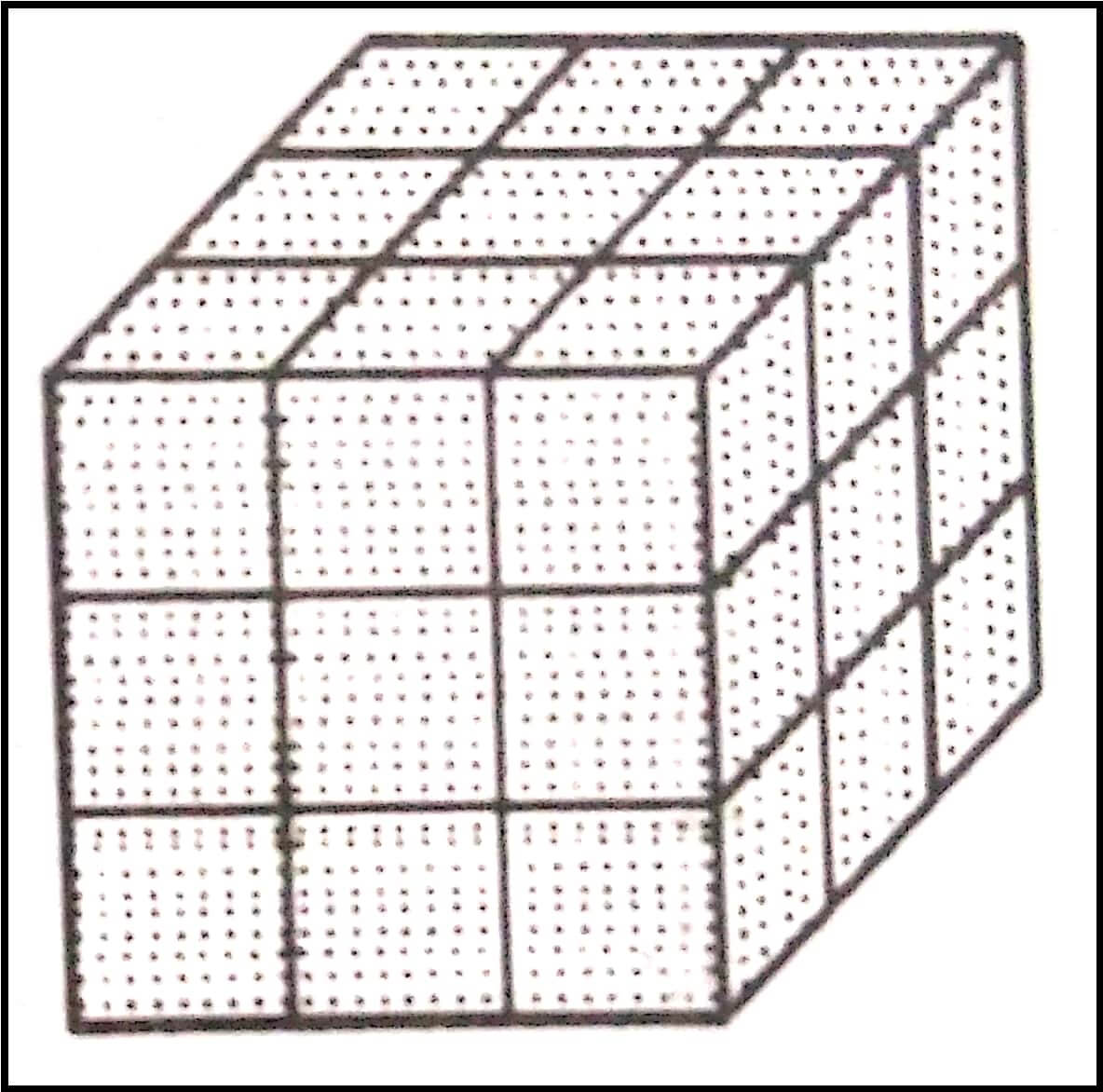Cubes - Cutting a Painted Cube

Cubes - Cutting a Painted Cube
Cubes - Cutting a Painted Cube: If a person cuts a piece of cube along any of its dimension then he gets two pieces. Now if someone makes ‘N’ number of cuts along its length then there will ‘N + 1’ number of pieces coming out of the original cube.
Now let us try with different number of cuts along different dimensions, if we have ‘L’ number of cuts along length, ‘B’ number of cuts along breadth and ‘H’ number of cuts along height then the number of pieces along these dimensions would be ‘L + 1’, ‘B + 1’ and ‘H + 1’ respectively.
Hence, total number of pieces would be (L + 1) (B + 1) (H + 1).
Let us start this with three cuts. Now we know for 3 cuts along a particular dimension there will be (3 +1) = 4 pieces.
But if we make 2 cuts along one dimension and 1 cut along another dimension then the number of pieces according to the formula given above will be (2 + 1) (1 + 1) = 6.So we can see that number of pieces would increase if we distribute the number of cutes along different dimensions.
Now here we can also consider one cut along each dimension. Where the number of pieces would be (1 + 1) (1 + 1) (1 + 1) = 8
Hence, to maximize the number of cuts here we should try to distribute the total number of cuts along each dimension as uniformly as possible.
Let us try some examples
Example : What’s the maximum number of pieces that can be obtained with 17 cuts without putting the pieces one above another?
A. 294
B. 296
C. 298
D. 300
Answer : 294
Explanation : Here, we can split 17 as 5, 6 and 6 which is the most equally distributed case. So the number of pieces will be (5 + 1) (6 +1) (6 + 1) = 294.
Example : A cube is coloured red on all faces. It is cut into 64 smaller cubes of equal size. Now, answer the following questions based on this statement :How many cubes have no face coloured?
A. 24
B. 16
C. 8
D. 10
Answer : C
Explanation : Since, there are 64 smaller cubes of equal size, therefore, n = no. of divisions on the face of undivided cube = 4
No. of cubes with no face coloured = (n – 2)³ = (4 – 2)³ = 8
If a cube is painted from the surfaces , When 2 cuts are made in Length, Breath, Height such that the resultant pieces are cubes.
How many cubes will have only two surface painted? | |||
| Right Option : C | |||
| View Explanation |
A solid cube of each side 8 cms, has been painted red, blue and black on pairs of opposite faces. It is then cut into cubical blocks of each side 2 cms.
How many cubes have only two face painted ? | |||
| Right Option : D | |||
| View Explanation | |||
A solid cube of each side 8 cms, has been painted red, blue and black on pairs of opposite faces. It is then cut into cubical blocks of each side 2 cms.
How many cubes have one face painted blue and one face painted red ? ( the other faces may be painted or unpainted) | |||
| Right Option : B | |||
| View Explanation | |||
Students / Parents Reviews [20]
My experience with Abhyas Academy has been very good. When I was not in Abhyas whenever teacher ask questions I could not speak it confidently but when I came in Abhyas, my speaking skills developed and now I am the first one to give the answer of teachers question.

Upmanyu Sharma
7thMy experience with Abhyas academy is very good. I did not think that my every subject coming here will be so strong. The main thing is that the online tests had made me learn here more things.

Hiya Gupta
8thWhen I have not joined Abhyas Academy, my skills of solving maths problems were not clear. But, after joining it, my skills have been developed and my concepts of science and SST are very well. I also came to know about other subjects such as vedic maths and reasoning.

Sharandeep Singh
7thAbhyas is good institution and a innovative institute also. It is a good platform of beginners.Due to Abhyas,he has got knoweledge about reasoning and confidence.My son has improved his vocabulary because of Abhyas.Teacher have very friendly atmosphere also.

Manish Kumar
10thIt was good as the experience because as we had come here we had been improved in a such envirnment created here.Extra is taught which is beneficial for future.

Eshan Arora
8thAbhyas is an institute of high repute. Yogansh has taken admission last year. It creates abilities in child to prepare for competitive exams. Students are motivated by living prizes on basis of performance in Abhyas exams. He is satisfied with institute.

Yogansh Nyasi
7thAbhyas Methodology is very good. It is based on according to student and each child manages accordingly to its properly. Methodology has improved the abilities of students to shine them in future.

Manish Kumar
10thAbhyas institute is one of the best coaching institute in the vicinity of Ambala cantt.The institute provides good and quality education to the students.The teachers are well experienced and are very helpful in solving the problems. The major advantages of the institute is extra classes for weak...

Shreya Shrivastava
8thThe experience was nice. I studied here for three years and saw a tremendous change in myself. I started liking subjects like English and SST which earlier I ran from. Extra knowledge gave me confidence to overcome competitive exams. One of the best institutes for secondary education.

Aman Kumar Shrivastava
10thOne of the best institutes to develope a child interest in studies.Provides SST and English knowledge also unlike other institutes. Teachers are co operative and friendly online tests andPPT develope practical knowledge also.

Aman Kumar Shrivastava
10thMy experience with Abhyas is very good. I have learnt many things here like vedic maths and reasoning also. Teachers here first take our doubts and then there are assignments to verify our weak points.

Shivam Rana
7thAbhyas institute is one of the best coaching institute in the vicinity of Ambala Cantt area. The teachers of the institute are well experienced and very helpful in solving the problems of the students.The good thing of the institute is that it is providing extra classes for the students who are w...

Aman Kumar Shrivastava
10thAbhyas academy is great place to learn. I have learnt a lot here they have finished my fear of not answering.It has created a habit of self studying in me.The teachers here are very supportive and helpful. Earlier my maths and science was good but now it has been much better than before.

Barkha Arora
10thIt has a great methodology. Students here can get analysis to their test quickly.We can learn easily through PPTs and the testing methods are good. We know that where we have to practice

Barkha Arora
10thMy experience with Abhyas academy is very nice or it can be said wonderful. I have been studying here from seven class. I have been completing my journey of three years. I am tinking that I should join Abhyas Academy in tenth class as I am seeing much improvement in Maths and English

Hridey Preet
9thIn terms of methodology I want to say that institute provides expert guidence and results oriented monitering supplements by requsite study material along with regular tests which help the students to improve their education skills.The techniques of providing education helps the students to asses...

Aman Kumar Shrivastava
10thAbhyas is a complete education Institute. Here extreme care is taken by teacher with the help of regular exam. Extra classes also conducted by the institute, if the student is weak.

Om Umang
10thMy experience was very good with Abhyas academy. I am studying here from 6th class and I am satisfied by its results in my life. I improved a lot here ahead of school syllabus.

Ayan Ghosh
8thI have spent a wonderful time in Abhyas academy. It has made my reasoning more apt, English more stronger and Maths an interesting subject for me. It has given me a habbit of self studying

Yatharthi Sharma
10thBeing a parent, I saw my daughter improvement in her studies by seeing a good result in all day to day compititive exam TMO, NSO, IEO etc and as well as studies. I have got a fruitful result from my daughter.





